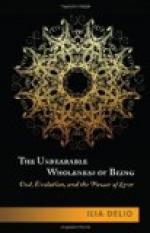The thought of the love-death is often present in the hearts of individuals who are genuinely in love. We read in Schlegel’s Lucinda: “There (in a transcendental life) our longings may perhaps be satisfied.” And in Lenau’s letters to Sophy the same thought is more than once apparent.
The idea reached perfection and immortality in Wagner’s “Tristan and Isolde.” It is Wagner’s world-famous deed to have lived through and embodied this complex of emotion for the first, and so far for the last time; his lovers are in a superlative degree representative of human love; they typify the climaxes of human emotion. Wagner has immortalised the metaphysical form of synthetic love; his importance to synthetic love surpasses Dante’s importance to deification.
Already in the first act the exchange of love-potion and death-draught is profoundly significant: both Tristan and Isolde seek death because they are alarmed by the external obstacles to their love. But the thought of death and love, the foreboding that their love can find rest only in the ultimate, in finality, has been in their hearts from the outset. Together they receive new life from love, and together love leads them, step by step, to death. In the profoundest sense no exchange of potions has taken place, but the power of the love-potion has made them conscious of what was latent in their souls, waiting to burst into life. At the very moment when Isolde proffers Tristan the death-draught, the conviction flashes into his soul that she is giving him death through love: “When thy dear hand the goblet raised, I recognised that death thou gav’st.” And in the same way Isolde: “From golden day I sought to flee, in darkest night draw thee with me, where my heart divined the end of deceit, where illusion’s haunting dream should fade, to drink eternal love to thee, joined everlastingly, to death I doom’d thee.”
The second act leads them further and further into the coils of their love; they are more and more convinced that death alone is left to them, step by step they discover the secret of the mystical union—and yet they are still completely imprisoned within the limits of their personalities and cannot quite understand the miracle: “How to grasp it, how to grasp it, this great gladness, far from daylight, far from




